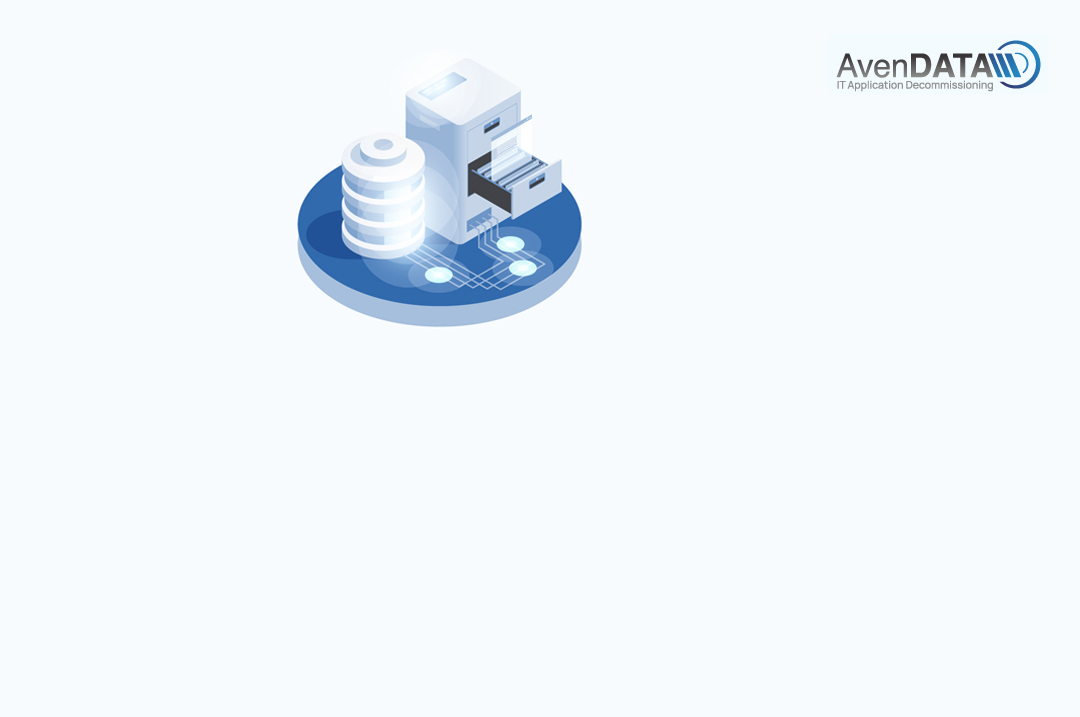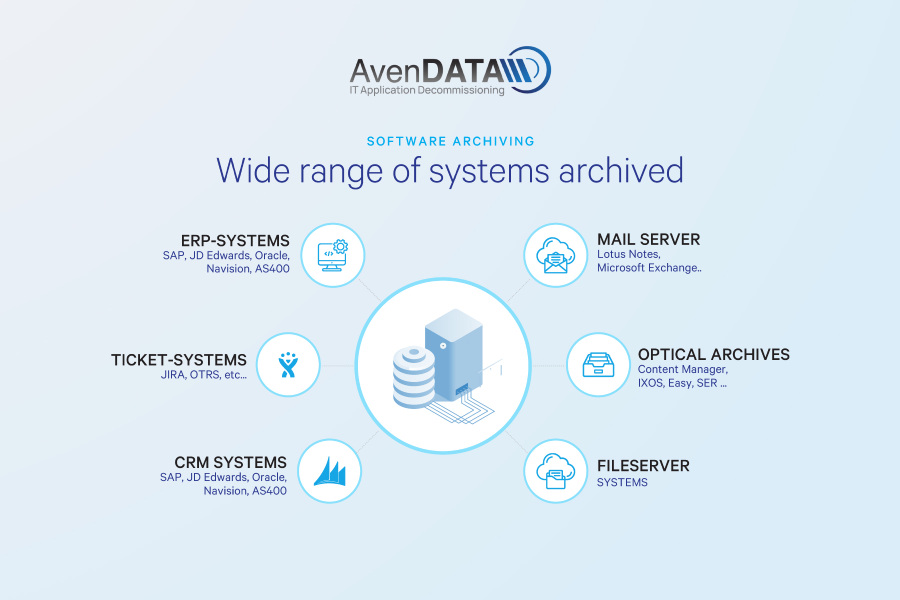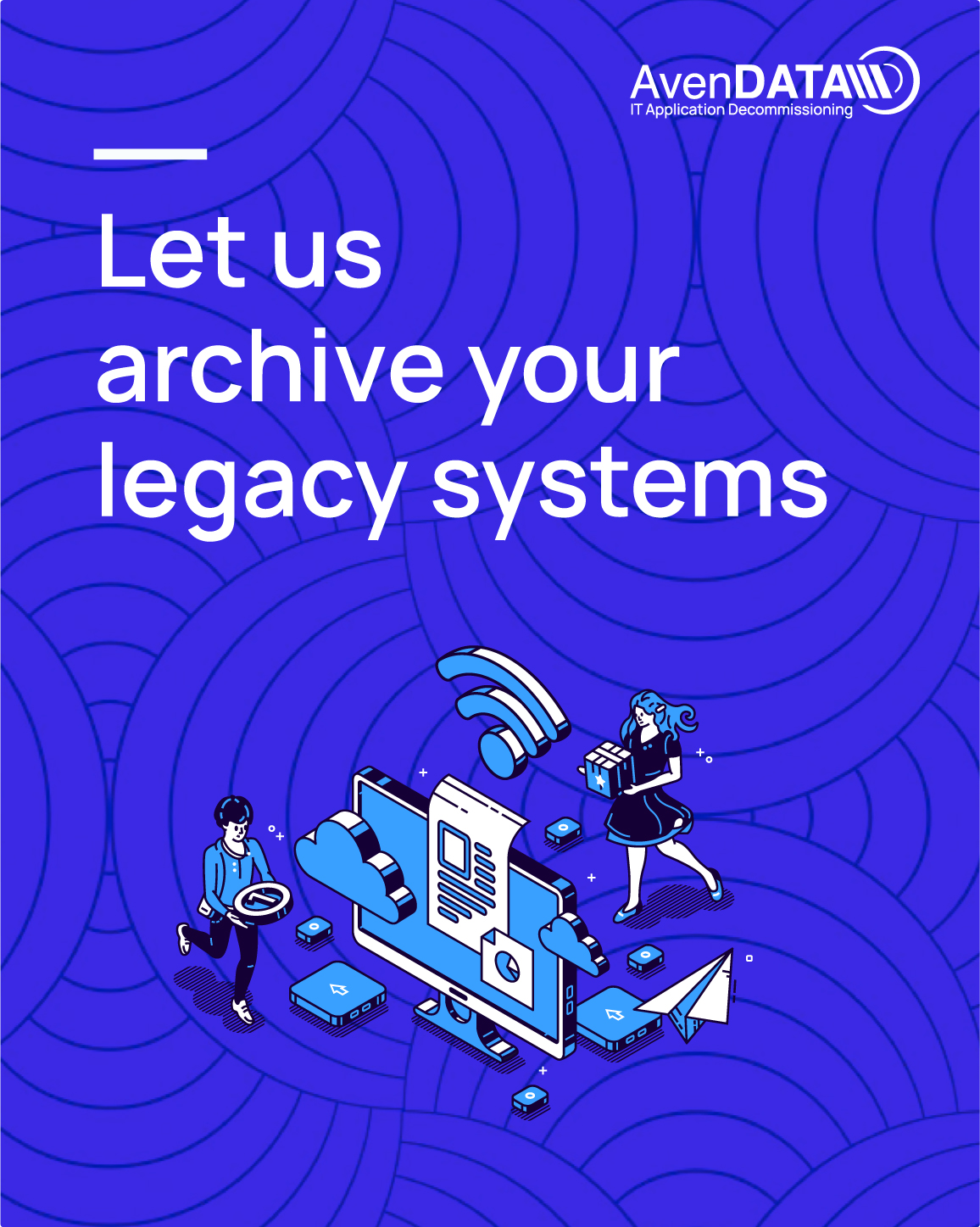Legacy System :
Definition, Challenges, Migration & Modernization
By AvenDATA

Table of Contents
- Introduction of Legacy Systems
- Why are legacy systems still used?
- Challenges and Complexities of Legacy Systems
- Examples of Legacy Systems
- Creating an IT Carve-Out Checklist
- Types of Legacy Systems
- Managing Legacy Systems
- Advantages & Disadvantages of Legacy Systems
- Legacy Systems Modernization
- Comparison with Modern Systems
- Why Archive Legacy Systems
- Conclusion
Understanding Legacy Systems
What is a legacy system?
A legacy system, in the realm of information technology (IT), refers to any outdated, often obsolete, or aging software or hardware infrastructure that is still in use within an organization due to its critical role in supporting various business processes. in simple words, A legacy system refers to outdated computer software, hardware, or technology still in use for daily operations. This can include software, applications, hardware, equipment, various file formats, and programming languages. These systems have typically been in place for many years and were often developed using outdated technologies and methodologies. Legacy systems can pose challenges for organizations in terms of maintenance, scalability, and integration with modern technologies.
- Outdated System
- Obsolete System
- Aging Infrastructure
- Heritage System
- Antiquated System
- Vintage Technology
- Traditional System
- Old-School System
- Historical System
- Dated Technology
- Inherited System
- Ancient System
Why are legacy systems still used?
- Investment Protection:
Companies may have made significant financial investments in developing or customizing legacy systems. The cost of migrating to a new system can be prohibitive, making organizations hesitant to abandon their existing infrastructure. - Business Critical Processes:Legacy systems often support critical business processes that are deeply embedded within an organization. Replacing these systems may disrupt essential operations and jeopardize business continuity.
- Fear of Change:Resistance to change is a common human trait, and this extends to organizational structures and systems. Employees may be comfortable with familiar interfaces and workflows, making the prospect of transitioning to a new system daunting.
- Obsolete Technology:Some legacy systems may be built on outdated technology or programming languages that are no longer widely supported. The lack of available expertise in these technologies makes migration a complex and risky endeavor.
- Lack of Documentation:Over time, documentation for legacy systems may become scarce or non-existent. This lack of documentation makes it challenging to understand the system’s intricacies, leading to uncertainty about the impact of migration.
Challenges and Complexities of Legacy Systems
• Outdated Technology: Legacy systems are built using technologies and programming languages that are no longer in widespread use or considered best practices. They may rely on obsolete hardware components as well.
• Limited or No Vendor Support: Most legacy systems are no longer actively supported by their original vendors. This lack of support makes it challenging to address security vulnerabilities, bugs, and compatibility issues.
• Inflexibility: Legacy systems are often rigid and difficult to modify or extend to meet new business requirements. This can hinder an organization’s ability to adapt to changing market conditions.
• High Maintenance Costs: Maintaining and troubleshooting legacy systems can be expensive and time-consuming. The scarcity of skilled developers familiar with outdated technologies can drive up labor costs.
• Integration Challenges: Integrating legacy systems with modern applications and technologies can be complex and costly. This can hinder an organization’s ability to leverage new innovations.
• Security Risks: Older systems may have security vulnerabilities that are difficult to address due to the lack of vendor support and the evolving threat landscape.
Examples of Legacy Systems
1. Mainframe Computers Mainframes are a classic example of legacy hardware. While they still power critical functions for many organizations, their technology is decades old. Many financial institutions, for instance, rely on mainframes for their core banking systems.
2. COBOL Applications COBOL (Common Business Oriented Language) is a programming language developed in the 1950s. Many organizations still use COBOL-based applications for functions like payroll processing, despite the language’s age and declining popularity.
3. Old ERP Systems Enterprise Resource Planning (ERP) systems are crucial for managing business processes. Some organizations continue to use outdated ERP software versions because migrating to a newer system can be complex and costly.
4. Legacy Database Systems Databases using older technology like dBase, FoxPro, or even early versions of SQL databases may still be in use for specific applications, despite the availability of more modern database solutions.
5. Custom-Built Systems Some organizations have custom software applications or systems developed in-house using technologies that have become outdated over time. These systems are often challenging to maintain and enhance.
Types of Legacy Systems
1. Hardware Legacy Systems These are legacy systems that involve outdated hardware components. Examples include old mainframe computers, proprietary hardware, and discontinued server architectures. These systems may require specialized maintenance and expertise.
2. Software Legacy Systems Software legacy systems are characterized by outdated software applications and codebases. This category includes applications developed using deprecated programming languages, obsolete software libraries, or operating systems that are no longer supported.
3. Infrastructure Legacy Systems Infrastructure legacy systems encompass outdated network architectures, communication protocols, and data storage methods. Organizations may still rely on legacy infrastructure due to the cost and complexity of upgrading.
4. Application Legacy Systems Application legacy systems refer to software applications or modules that have become outdated but are still essential for specific business functions. Examples include legacy CRM (Customer Relationship Management) systems or order processing applications.
5. Database Legacy Systems Legacy database systems involve outdated database management systems (DBMS) or data storage structures. Migrating data from these systems to modern databases can be challenging due to differences in data models and schemas.
6. Custom Legacy Systems Custom-built legacy systems are unique to an organization and may include a combination of outdated hardware, software, and infrastructure components. These systems are often tightly integrated with the organization’s processes and can be difficult to replace.
7. End-of-Life Systems End-of-life legacy systems are those for which the vendor has officially ceased support and development. These systems are particularly vulnerable to security risks and may require immediate attention or replacement.
Managing Legacy Systems
• Modernization: Gradually updating or replacing outdated components of the system to make it more compatible with modern technologies.
• Migration: Planning and executing the migration of data and functionality from legacy systems to newer, more efficient platforms.
• Integration: Implementing integration layers or middleware to connect legacy systems with modern applications, allowing them to work together seamlessly.
• Retirement: Identifying and phasing out legacy systems that are no longer critical to business operations or can be replaced by more efficient alternatives.
• Emulation: Using emulation or virtualization to run legacy software on modern hardware, allowing it to continue functioning while minimizing hardware maintenance issues.
• Documentation: Thoroughly documenting legacy systems to aid in their maintenance and future replacement.
• Training: Providing training and knowledge transfer to ensure that employees can maintain and operate legacy systems effectively.
Advantages & Disadvantages of Legacy systems

Advantages of Legacy Systems:
1. Proven Reliability: Legacy systems have stood the test of time. They’ve proven their reliability by functioning effectively for years. Organizations can count on these systems to keep their operations running smoothly.
1. Costly Maintenance: Legacy systems can become expensive to maintain as they age. Finding skilled professionals to manage and troubleshoot these systems can be challenging and costly.
Organizations must carefully weigh these pros and cons when deciding whether to continue relying on legacy systems or invest in modern solutions that can drive innovation and efficiency.
Legacy Systems Modernization

Legacy system modernization is a basic endeavor for associations expecting to
remain cutthroat, improve functional productivity, and adjust to the developing innovative
scene. In this thorough aide, we’ll investigate the ideas, methodologies, difficulties, and
advantages related with modernizing Legacy systems.
Legacy System modernization alludes to the most common way of redesigning or
changing obsolete programming, equipment, or foundation parts to adjust them to current
mechanical guidelines and business needs. Legacy Systems are commonly described
by obsolete innovation stacks, old programming dialects, and an absence of versatility or
adaptability. Modernization plans to resolve these issues while protecting the important
information and usefulness of the current framework.
The Need for Modernization
Modernizing legacy systems is a strategic move that addresses these challenges and
unlocks several benefits:
Legacy systems frequently come up short on abilities and elements of current arrangements. Modernization can further develop framework execution, responsiveness, and client experience, prompting expanded proficiency in business processes.
Keeping up with and supporting Legacy systems can be exorbitant because of the shortage of talented assets and the requirement for specific equipment. Modernization can diminish long haul functional costs.
Legacy systems might have security weaknesses that are hard to fix or obsolete consistence norms. Modernization assists associations with meeting current security and administrative necessities.
Legacy systems might battle to oblige developing information volumes or expanded client loads. Modernization can make frameworks more versatile and versatile to changing business needs.
Legacy systems permit associations to use new innovations, gain an upper hand, and answer all the more rapidly to showcase requests.
Modernization Approaches
There are various approaches to legacy systems or applications modernization, each tailored to the specific needs and constraints of an organization:
Legacy system or application modernization is a strategic investment that enables organizations to harness the full potential of their existing systems while preparing for future challenges and opportunities. By addressing the limitations of legacy applications, organizations can enhance efficiency, reduce costs, improve security, and remain agile in a rapidly evolving business landscape.
Genuine Cases of Legacy System Modernization
Comparison of legacy systems with modern systems
Certainly! Below is a table outlining a comparison between legacy systems and modern systems across various aspects:
| Aspect | Legacy Systems | Modern Systems |
|---|---|---|
| Technology and Architecture | Often built on outdated technology and architecture | Utilizes the latest technology and scalable architectures |
| Integration and Interoperability | Limited integration capabilities, siloed data | Designed for seamless integration and interoperability |
| Scalability | Typically lacks scalability, challenging to expand | Designed to scale easily to accommodate growth |
| User Interface and Experience | Outdated interfaces, may lack user-friendly features | Modern, intuitive interfaces, enhanced user experience |
| Maintenance and Updates | Expensive and complex maintenance, fewer updates | Streamlined maintenance, frequent updates and patches |
| Security | More vulnerable to security threats and breaches | Emphasizes robust security measures, regular updates |
| Costs | High maintenance costs, expensive to upgrade | Lower maintenance costs, efficient use of resources |
| Flexibility and Adaptability | Limited flexibility and adaptability to new trends | Adaptable to changing business requirements |
| Speed and Performance | May experience slower performance | Optimized for speed and superior performance |
| Data Handling and Analytics | Data handling may be cumbersome, limited analytics | Efficient data handling, advanced analytics capabilities |
| Compliance | May struggle to meet current compliance standards | Built with compliance in mind, adheres to industry standards |
Why do we need to archive legacy systems?
- Initially developed with little or no documentation and with standardized interfaces
- High implementation and maintenance costs
- These systems are not supported by the manufacturer
- Unavailability of competent personnel to manage these legacy systems
- These systems are prone to security risks as they lack compatibility with the latest security features

legacy systems are a common challenge for organizations across various industries. They is
they can be a source of stability; they also pose risks and limitations. Effective management
and, when necessary, replacement or modernization of legacy systems are crucial for
organizations to remain competitive and secure in the ever-evolving world of technology.
-
SAP Carve-Out Guide: Definition, Process, Benefits
-
System Decommissioning: A Strategic Guide
-
20 Reasons why legacy ERP systems must be archived and data should not be deleted
-
IT Mergers and Acquisitions: The ABCs of a Successful Integration
-
Mastering IT M&A and Carve-Outs: Addressing Pain Points with Practical Solutions
-
Modernizing Legacy Systems: A Strategic Guide for IT Company Owners
-
The importance of legacy systems is steadily increasing
-
Ten Key Questions with Emanuel Boeminghaus
-
How to Decommission Legacy Applications?
-
Liquidation and Insolvency in the IT Sector: Understanding the Impact

